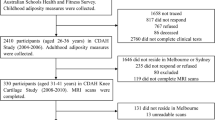Abstract
Purpose
Findings from cross-sectional studies of knee angle development in Nigerian children vary in values and in the age at which the varus angle changes to the valgus angle. This study was conducted to describe knee angle development and to determine the age when the knee angle changes from the varus to the valgus angle.
Methods
This was a longitudinal survey of 152 Nigerian children recruited within 3 weeks of life and followed up monthly until age 3 years. Their knee angle was measured using clinical methods.
Results
The mean tibio-femoral/varus knee angle (13.2 ± 3.8°) at birth–3 weeks of life decreased sharply to 5.6 ± 0.7° at 9 months, increased slightly to 6.3 ± 1.1° at 13 months, and then decreased again up to age 18 months (0.3 ± 2.1°). The mean valgus knee angle increased from −2.4 ± 2.5° at 19 months of life to −8.5 ± 2.5° at 27 months and then decreased to −7.7 ± 2.2° at 36 months. Intercondylar/intermalleolar distances (ICD/IMD) showed a similar pattern, changing from an extreme varus knee (ICD) at birth–3 weeks of life (2.5 ± 0.7 cm), decreasing to 0.6 ± 0.2 cm at 9 months, increasing to 0.8 ± 0.5 cm at 12 months, and decreasing to 0.1 ± 0.4 cm at 15 months. The mean IMD increased from −0.1 ± 0.8 cm at 16 months of life to −2.0 ± 1.5 cm at 29 months and then decreased up to 36 months. Our tri-modal analysis showed that the transition from the varus to the valgus angle was between 18 and 19 months.
Conclusion
Our findings suggest that the developmental pattern of the knee angle in Nigerian children is at maximal varus at birth, neutral at 18 months of life, and valgus at 19 months, with the valgus angle continuing to increase up to 36 months.





Similar content being viewed by others
References
Davids JR, Blackhurst DW, Allen BL (2001) Radiographic evaluation of bowed legs in children. J Pediatr Orthop 21:257–263
Heath CH, Staheli LT (1993) Normal limits of knee angle in white children—genu varum and genu valgum. J Pediatr Orthop 13:259–262
Oginni LM, Badru OS, Sharp CA, Davie MWJ, Worsfold M (2004) Knee angles and rickets in Nigerian children. J Pediatr Orthop 24:403–407
Yoo JH, Choi IH, Cho T, Chung CY, Yoo WJ (2008) Development of tibiofemoral angle in Korean children. J Korean Med Sci 23:714–717
Salenius P, Vankka E (1975) The development of the tibiofemoral angle in children. J Bone Joint Surg Am 57:259–261
Cheng JC, Chan PS, Chiang SC, Hui PW (1991) Angular and rotational profile of the lower limb in 2,630 Chinese children. J Pediatr Orthop 11:154–161
Arazi M, Ogun TC, Memik R (2001) Normal development of the tibiofemoral angle in children: a clinical study of 590 normal subjects from 3 to 17 years of age. J Pediatr Orthop 21:264–267
Omololu B, Tella A, Ogunlade SO, Adeyemo AA, Adebisi A, Alonge TO, Salawu SA, Akinpelu AO (2003) Normal values of knee angle, intercondylar and intermalleolar distances in Nigerian children. West Afr J Med 22:301–304
Ezeuko VC, Owah S, Ukoima HS, Ejimofor OC, Aligwekwe AU, Bankole L (2010) Clinical study of the chronological changes in knee alignment pattern in normal south-east Nigerian children aged between 0 and 5 years. Electron J Biomed 1:16–21
Saini UC, Bali K, Sheth B, Gahlot N, Gahlot A (2010) Normal development of the knee angle in healthy Indian children: a clinical study of 215 children. J Child Orthop 4:579–586
Oyewole OO, Akinpelu AO (2011) Developmental pattern of tibio-femoral angle in a cohort of Nigerian children: a preliminary report. Internet J Allied Health Sci Pract 9(4):1–6
Eng J (2003) Sample size estimation: how many individuals should be studied? Radiology 227:309–313
Qureshi MA, Soomro MB, Jokhio IA (2000) Normal limits of knee angle in Pakistani children; a photographic study of genu varum and genu valgum. Professional 7:221–226
Lin C, Lin S, Huang W, Ho C, Chou Y (1999) Physiological knock-knee in preschool children: prevalence, correlating factors, gait analysis, and clinical significance. J Pediatr Orthop 19:650
Abdel Rahman SA, Badhdah WA (2011) Normal development of the tibiofemoral angle in Saudi children from 2 to 15 years of age. World Appl Sci J 12:1353–1361
Qureshi MA, Soomro MB, Jokhio IA (2000) Knee angle development in Karachi children. A clinical assessment by measuring tibial length and intercondylar or intermalleolar distance. Professional 7:482–491
Author information
Authors and Affiliations
Corresponding author
About this article
Cite this article
Oyewole, O.O., Akinpelu, A.O. & Odole, A.C. Development of the tibiofemoral angle in a cohort of Nigerian children during the first 3 years of life. J Child Orthop 7, 167–173 (2013). https://doi.org/10.1007/s11832-012-0478-z
Received:
Accepted:
Published:
Issue Date:
DOI: https://doi.org/10.1007/s11832-012-0478-z




